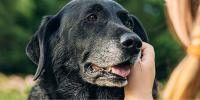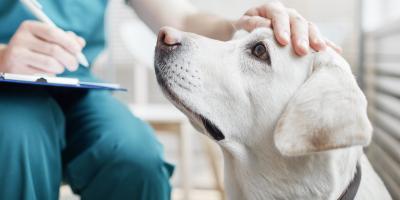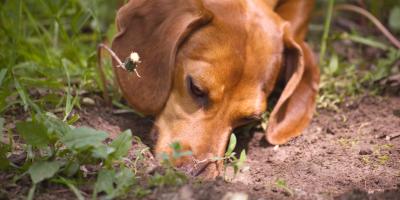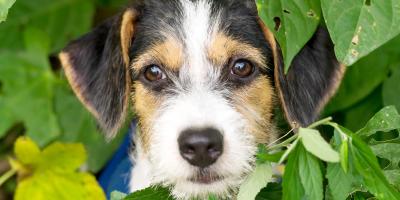How to Help Prevent Pain From Exercise


Help Your Dog Avoid Injury When You Share Outdoor Activities
We all know that canine exercise, including outdoor activities, benefits your dog and your relationship with them. Here are some things to keep in mind, to help keep your dog’s exercise sessions pain – and injury – free.
What Are the Most Common Causes of Exercise-Related Pain?
Dogs of different ages, sizes, and breeds can be susceptible to different types of injuries. In addition, seasonal and environmental factors can also impact your dog.
- Puppies whose bodies are still developing can suffer pain resulting from repetitive exercise or lengthy exercise sessions. There can also be injury because their coordination isn’t developed yet.
- Senior dogs can experience pain in their joints due to pre-existing conditions like arthritis and intervertebral disk disease, or overexertion.
- Toy and small breed dogs can have pre-existing issues such as luxating patella, which means that their kneecaps can be prone to popping out. This can be exacerbated by exercise.
- Medium and large breed dogs, especially Labradors, Golden Retrievers, and German Shepherds, can suffer from hip dysplasia that can progress more quickly into arthritis. Another common injury, especially for Labradors, is a torn anterior cruciate ligament (ACL) in the knee.
- Outdoor activities in winter carry the risk of cold temperatures, snowy or icy surfaces and exposure to ice melt substances. Here are some tips for exciting and safe winter activities with your dog.
- Outdoor activities in summer come with risks associated with hot temperatures and surfaces. Get some tips on how you can beat the heat and enjoy water activities with your dog.
- Activities in wooded areas can mean exposure to ticks and fleas, as well as injuries to paws traveling on unpaved trails.
How Can These Types of Exercise-Related Pain Be Avoided?
Purina Veterinarian, Dr. RuthAnn Lobos offers these tips on how to avoid injury during (or due to) some of these specific outdoor activities:
- For puppies, Dr. Lobos recommends avoiding repetitive exercise on hard surfaces until a puppy’s growth plates are closed. This amount of time can vary by breed. “In small to medium size breeds the growth plates usually close between nine months and a year. For larger breeds such as Labradors and Great Danes, the growth plates can stay open sometimes as long as 18 to 24 months,” she says. “So keeping exercise sessions on soft surfaces and of shorter duration is important.”
- Senior dogs need special care during exercise. Dr. Lobos recommends a veterinarian visit for a realistic fitness evaluation before starting any new activity, and a slow build in activity to increase endurance and avoid pain or other issues resulting from overuse.
- Toy and small breed dogs need to be supervised during exercise to make sure their joints are handling the activity. Be sure to start any new activity slowly, avoid overwork (especially on the knees), and make sure your little dog stays hydrated.
- Medium and large breed dogs benefit from staying fit and maintaining lean body mass, advises Dr. Lobos. Obesity, as well as overexertion, can contribute to injuries such as ACL tears during exercise.
- Outdoor activities in winter should only be carried out if temperatures allow it safely. Guidance from Dr. Lobos is that if it’s too cold for you in your winter coat, it’s too cold for your dog. If you’re going outdoors aim for midday, when temperatures are warmer and visibility is better. Avoid icy surfaces, as well as those with ice melting substances such as rock salt, which can cause irritation and injury to your dog’s paws. Investing in dog booties can help keep your dog’s paws warmer, and safer, in wintry weather.
- Outdoor activities in summer should be conducted with caution. If you’re walking on sidewalks or asphalt, check the surface temperature to make sure it won’t injure your dog’s paws. Dr. Lobos advises, “If it’s too hot for your hand to touch for five-to-ten seconds, it’s too hot for your dog’s paws.” Consider limiting summer outdoor exercise to early morning or later evening.
- Activities in wooded areas, such as hiking, require planning and a well-stocked first-aid kit. Make sure yours includes items such as tweezers for removing ticks, sterile eye wash, and antibiotic ointment, plus a tensor (ACE) bandage, gauze bandage, sponges, and adhesive tape for treating wounds.
By following these tips, you can enjoy an active life with your dog more confidently, and more effectively help them avoid pain related to exercise.
Remember also that just as important as helping your dog avoid pain from exercise is fueling that activity with a quality food. From puppy to senior, and all the years and activities in between, Pro Plan Sport formulas offer high-performance nutrition tailored to your dog’s life stage, and active lifestyle, to help strengthen their body and promote recovery. Pro Plan Sport offers an entire line of focused formulas including options for puppies, large breed puppies, and senior dogs.
Related articles

Reward Yourself with myPurina
Earn and redeem rewards for Purina products with the myPurina app.





